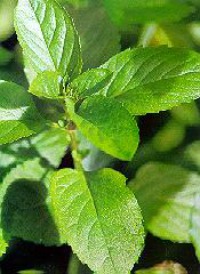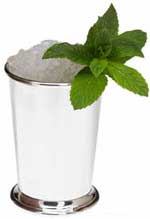Mint Leaves – Peppermint and Spearmint
 Peppermint is the premier mint for flavoring candy, gum, and other sweets. Commercially prepared oil or extract are better for these uses than anything you can concoct at home from the fresh herb. For most culinary purposes, garden peppermint is a bit strong. When to do use it, harvest only the young leaves. The older leaves and the stems tend to be bitter.
Peppermint is the premier mint for flavoring candy, gum, and other sweets. Commercially prepared oil or extract are better for these uses than anything you can concoct at home from the fresh herb. For most culinary purposes, garden peppermint is a bit strong. When to do use it, harvest only the young leaves. The older leaves and the stems tend to be bitter.
Spearmint and curly mint are more versatile for culinary uses. Milder than peppermint, they enhance all sorts of meat, fish, or vegetable dishes.
All the mints are best used fresh and should be stored only briefly, in plastic bags in the refrigerator. They may be frozen in ice-cube trays. Dried leaves should be kept in an airtight container in a cool, dark place.
History of Mint:
Peppermint and spearmint came to the New World with the colonists, who also used them medicinally. They drank mint tea for headaches, heartburn, indigestion, gas, and to help them sleep. They also drank mint tea for pure pleasure, especially since it was not taxed.
Culinary Ideas for Mint:
Mint leaves tangy sweet flavor have a cool aftertaste that makes it delightful in many delicious ways. A few are:
 Crush mint leaves and fold them in whipped cream for an excellent topping on chocolate desserts.
Crush mint leaves and fold them in whipped cream for an excellent topping on chocolate desserts.
Sprinkle freshly-minced mint leaves on garden-fresh tomato slices.
Make traditional Mint Sauce for lamb.
Jellies, sherbets, ice cream, and Sorbet.
Make a tall glass of Mint Julep or Iced Tea or Sweet Tea.
Make Mint Water. Twist or bruise 1 cup of peppermint, spearmint, or other mint. Place in a clean half-gallon container. fill with fresh, cool water. Chill in refrigerator. Strain and serve on ice. So refreshing! Try washing your face in Mint Water – Again, very refreshing!
Growing Mint:
Mint is found growing wild on many a shady creek bank. Mint must have lots of water and will spread quickly into a bed. I find the best way to plant mint is to plant in a container. This will keep the mint from taking over your gardens.
Learn how to dry and store fresh mint: Drying Mint
Mint Tips:
A tiny vase of fresh mint sprigs gives a cool fragrance to a room. The secret is to crush 2 or 3 leaves and drop them inside the vase before arranging the sprigs.
Also tuck sprigs of mint in your centerpiece on the dining room table.
Questions from Readers:
Question:
Can you put fresh mint in a dehydrator to use later. If so how long can you store it? Thanks You – Donna (4/28/02)
Answer:
Yes, you can dry fresh mint leaves. Mint is done just the same as other herbs you might dry. Most herbs are at their peak flavor just before flowering, so this is a good time to collect them for drying and storage.
To be certain, check drying directions on specific herbs in a reliable reference book. Cut off the herbs early in the morning just after the dew has dried. Cut annuals off at ground level, and perennials about one-third down the main stem, including the side branches.
Wash herbs, with the leaves on the stems, lightly in cold running water to remove any soil, dust, bugs, or other foreign material. Drain thoroughly on absorbent towels or hang plants upside down in the sun until the water evaporates.
Strip leaves off the stalks once plants have drained and dried, leaving only the top 6 inches. Remove all blossoms.
Natural or Air Drying:
Herbs must be dried thoroughly before storing. Herbs with high moisture content, such as mint and basil, need rapid drying or they will mold. To retain some green leaf coloring, dry in the dark by hanging plants upside down in bunches in paper bags. Hanging leaves down allows essential oils to flow from stems to leaves. Tie whole stems very tightly in small bunches. Individual stems will shrink and fall. Hang in a dark, warm (70 to -80 degrees F.), well-ventilated, dust-free area. Leaves are ready when they feel dry and crumbly in about 1 to 2 weeks.
Over Drying:
For quick oven drying, take care to prevent loss of flavor, oils, and color. Place leaves or seeds on a cookie sheet or shallow pan not more than 1 inch deep in an open oven at low heat less than 180oF (82.2oC) for about 2 to 4 hours.
Microwave ovens can be used to dry leaves quickly. Place the clean leaves on a paper plate or paper towel. Place the herbs in the oven for 1 to 3 minutes, mixing every 30 seconds.
Storage:
When completely dry, the leaves may be screened to a powder or stored whole in airtight containers, such as canning jars with tightly sealed lids. For a few days, it is very important to examine daily the jars in which you have stored dried herbs. If you see any moisture in the jars, remove the herbs and repeat the drying process. Herbs will mold quickly in closed jars if not completely dry.
Once you are sure the herbs are completely dry, place them in the airtight containers, and store them in a cool, dry place away from light. Never use paper or cardboard containers for storage as they will absorb the herbs’ aromatic oils.
Categories:
Herbs, Spices and Seasoning Hints & Tips